Dive courses where you want
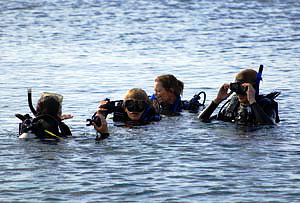
If you are not certified yet as a diver or you would like to continue your dive education up until "DIVEMASTER" we can give these dive courses ourselves since we are certified PADI instructors with additional EFR (Emergency First Response) and Nitrogen certification.
When we give the course we only teach you and whoever is with you and nobody else.
With two instructors at your side you will have the guarantee of full attention throughout the course.
In case you're with a group of more than 6 people we will get assistance from one or more Divemasters.
We give the courses in Tulamben, Amed and Pemuteran, in Bali, because of the easy water conditions for learning.
Of course we can also team you up with a dive operator with instructor with whom we cooperate and know are good.
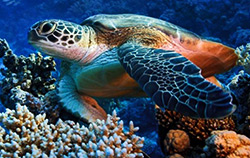
Before we became PADI-instructors we started diving in the Netherlands with CMAS and we were taught the "hard" way.
Six months training in a swimming pool before you went into the abyss.
The 1-star CMAS then used to be "decompression" diving using the US Navy tables for calculating your maximum bottom time including
"decompression stops" whenever required. You could say it was comparable with PADI's Open Water,
Advanced Open Water and Rescue course combined, but still with a maximum depth limit
of 18m.
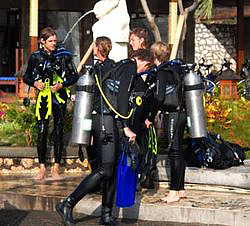
Nowadays diving has become more accessible and all the dive organizations make the whole process of "learning how to dive" easier with low-level entry requirements.
For one thing, PADI courses are based on "no-decompression diving" which means you can always abort your dive and ascend to the surface, in a controlled manner, without risking getting "decompression sickness" or "the bends" as it used to be called.
PADI courses can take you from an inexperienced novice to the level of a professional diver. Bali is the perfect place to learn with easy accessible dive spots for practising.
But still, the Open Water diver course is quite demanding for people, and you should take that in consideration before doing this on your holiday.
We always recommend people to read the Open water manual before starting this course....
Recently PADI has started 'E-learning' where the theory part can be done over the internet before going on holiday.
If you need more information please let us know by filling out the Contact us form.
Note 2: Upon certification you will be issued a temporary PADI card by your instructor which can be used immediately. PADI will send the plastic card to an address of your choice after processing the application which usually takes between one and two months.
Note 3: Course durations mentioned below are a (conservative) indication of how long these will take. If you need more time we can extend the duration to suite your needs. PADI's dive course are "performance based" so skills and exams will be repeated until done satisfactory...
- Discover Scuba divingTop
- The PADI Discover Scuba Diving program is for those who would like to try out diving first before signing up for a course. In this short introduction to diving (around 2 hours) you will learn the very basic skills and do the following:
-
- Watch an introduction video, and get a quick briefing from your instructor
- Don your scuba gear and, with your instructor, try it out in the swimming pool
- Do a few exercises in the pool until your feel comfortable with the equipment
- Join your instructor to take your first shore dive in the (shallow) open water and enjoy!
-
- Everything mentioned above:
- on request
- Scuba diverTop
- The PADI Scuba Diver program is for those people who like to experience diving on occasion but will have no desire to do any diving
without the supervision of a Divemaster and - or Instructor.
This course is an abbreviated version of the Open Water diver course were you will learn and do the following: -
- A classroom session of (in total) a day covering the basic theory and skills and includes written exams
- A pool session of a day where the theory will be tested in the pool
- Make 2 open water dives with your instructor were the skills will be tested once more in the open water
- Join your instructor to make an extra fun dive !
-
- The above incl. RDP:
- on request
- Open water diverTop
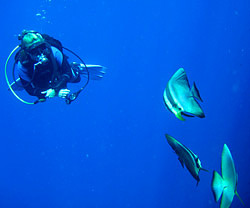
- Entry level dive course of usually 4 - 5 days were you will learn all the theory and skills to dive together with a buddy without
supervision. With your certification card you can rent tanks and equipment and go (boat)diving with other people all over the
world.
Don't underestimate this course; it is an extensive course which will take up a lot of time when given properly.
The duration of the course can be adjusted if certain aspects of it take more time....
In short the course is as follows: -
- Classroom sessions, introduction videos and oral and written exams
- Pool sessions where the theory will be tested in the pool until mastered satisfactory
- Make 4 open water dives over 2 days with your instructor were the skills will be tested once more in the open water
-
- The above incl. RDP:
- on request
- Advanced Open Water diverTop
-
One of the most important reasons for taking the advanced course is to overcome the limit of 18m depth from
the Open Water diver course.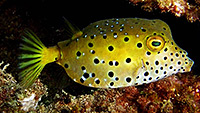
Many dive trips, especially if you go by boat further away from shore, will bring the group you may have joined deeper than what you have experienced so far.
During this course you will be tested if you are susceptible for "nitrogen narcosis" which may occur going deeper than 30m.
This is just one of the 5 "adventure" dives but mandatory together with the Navigation dive.There are 3 other specific types of dive to choose from: Aware fish identification, Boat dive, Drift dive, Enriched air dive, Multilevel and Computer dive, Night dive (highly recommended), Peak Performance Buoyancy, Search & Recovery dive, Underwater Naturalist dive, Digital Underwater Photography and Wreck diving.
The duration of the course is 3 full days whereby the emphasis is on the diving since the theory of most of the subjects has already been covered by the Open Water diver course.
Note: Any of these Adventure dives can also be done separately and later on be credited towards your Advanced Open Water certification or Speciality Diver program. -
- Classroom sessions, introduction videos and oral and written exams
- Five open water dives where skills will be tested by your instructor
-
- Everything mentioned above:
- on request
- Emergency First ResponseTop
- This course is not only mandatory if you continue your education to become a Rescue diver but is also very useful in daily
life. The program is composed of two core modules :
Primary Care (CPR) teaches you how to deal with emergencies that are immediately life threatening.
Secondary Care (first aid) covers injuries or illnesses that are not immediately life threatening or when local EMS is unavailable or delayed.
You will learn through a combination of knowledge development, skill development and realistic scenario practice to make sure you have the knowledge, understanding and confidence to use your skills. -
- One day in classroom with theory and practical application
-
- Everything mentioned above:
- on request
- Rescue diverTop
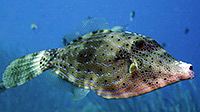
-
Arguably the most rewarding and memorable course for people who have done it. This training expands the basic problem prevention and accident management skills student divers learn beginning with the Open Water Diver course.
Although serious and demanding it is a course full of scenarios and practical application of techniques in rescuing other divers.
After completing this course and with the skills you have learned during your EFR course you will find yourself confident to handle any possible dive related emergency which may occur above and below the surface. -
- A full day of theoretical sessions, instruction videos and oral and written exams
- A full day in the swimming pool practising rescue techniques
- Two more days in the open water with your instructor acting out scenarios
-
- The above incl. Rescue slate:
- on request
- DivemasterTop
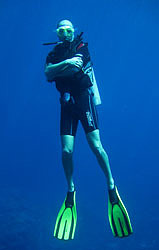
- This first professional level in diving will bring your skills to almost the level of an instructor so this is not something you
will commit yourself to unless you truly love to dive.
During your divemaster course you will further enhance your underwater skills up to a level were you can assist an instructor in teaching.
In this course it is not about yourself anymore rather than conveying your diving know-how to somebody else in a professional way.
Once a divemaster (besides assisting the instructor) you can conduct the following exercises independently:
Skin Diver,Discover Local Diving and Scuba Review programs.
Note: At the start of this course students must have completed at least 20 dives and need to have done 60 dives upon certification. -
- One full month of knowledge, confined and open water training
-
- Everything mentioned above:
- on request
- Enriched Air (Nitrox) courseTop
- If you want to extend your allowable bottom time while at the same time making your dives safer then the PADI Enriched Air (Nitrox) course gives you exactly that. In this course you'll learn how to safely use enriched air with an oxygen content ranging from 22% to 40% to allow you to have longer bottom times, make more dives in a day and shorten surface intervals.
- For Example: the PADI Recreational Dive Planner has a maximum dive time of 80 minutes at 16m on air but, if you use Enriched Air
with 36% oxygen that time is changed to 220 minutes. Talk about adding a safety factor!
Note: The Enriched Air course is also the only PADI course you can take at the same time as another course like the Advanced Openwater Diver course so you can complete 2 courses at once. You can even start this course before finishing your Openwater Diver Course if you are at least 15 years old and must have an Openwater diver certification or have completed the first 3 dives of the Openwater course. -
- Learn why and how "enriched air" is different from "normal air"
- Learn to use the Enriched air tables
- Analyzing Enriched Air tank fills and make 2 open water dives
-
- The above incl. Enriched air tables:
- on request
The PADI program
Your instructors can be checked on PADI's website
using their member numbers:
Joan Keijer#477741
Eelco Nieuwenhuis#477742
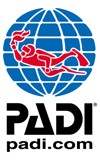


We can teach you the following courses and make you a:
- Discover Scuba diver
- Scuba diver
- Open Water diver
- Advanced Open Water diver
- Emergency First Responder
- Rescue diver
- Dive master
- Enriched air diver
Project aware
 By donating a small amount of money (US$10,-) upon certification you help this organization to finance amongst others the placing of
mooring buoys, cleaning up reefs and campaigning for the preservation of marine species.
By donating a small amount of money (US$10,-) upon certification you help this organization to finance amongst others the placing of
mooring buoys, cleaning up reefs and campaigning for the preservation of marine species.
For more information :
